Esterbrook Classic M2 c. 1959-1962
by Jim Mamoulides, July 5, 2024
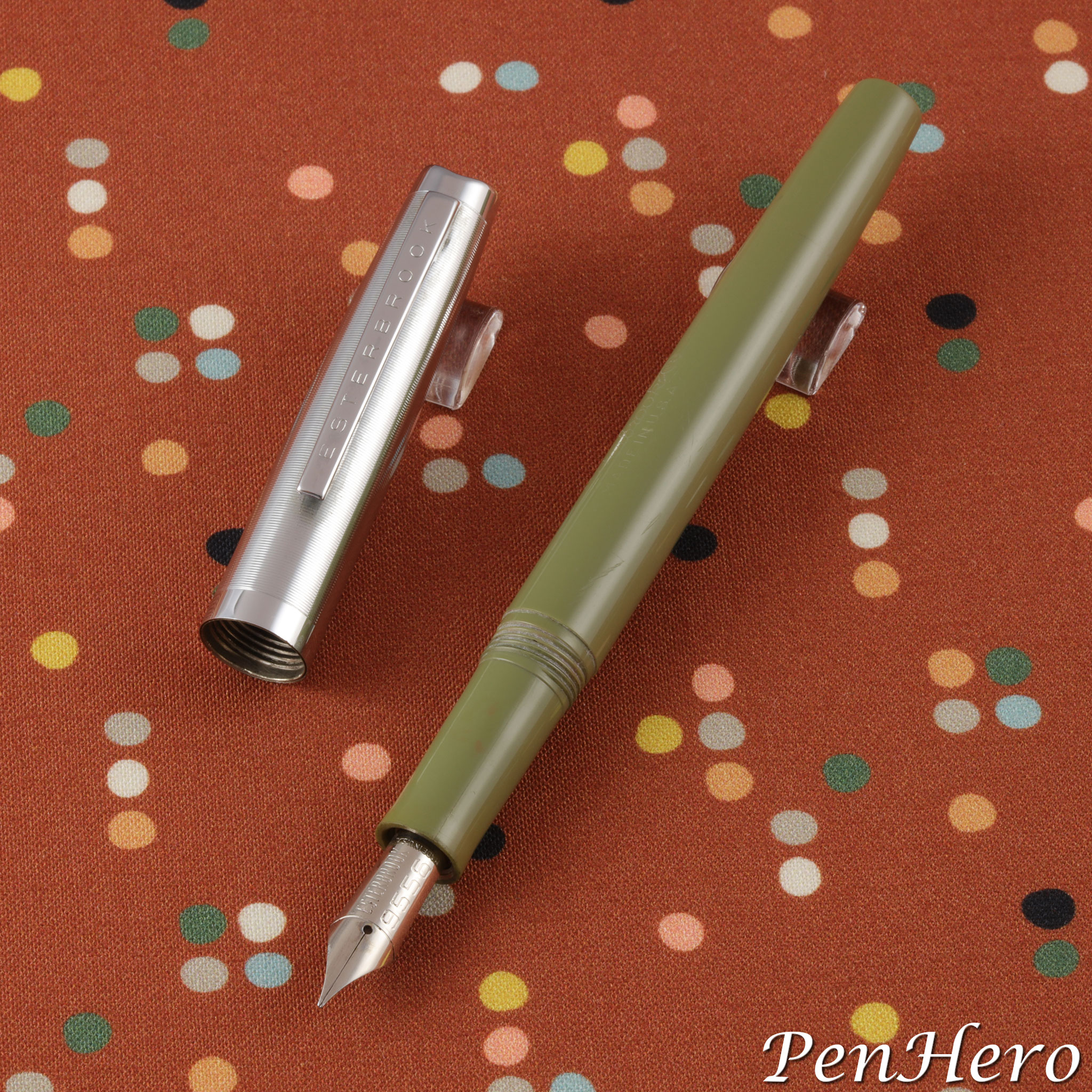 Esterbrook Classic M2 Mistletoe Green, second version, c. 1961-1962
Esterbrook Classic M2 Mistletoe Green, second version, c. 1961-1962
The Squeeze Is On!
Esterbrook’s most popular and best-selling fountain pen has to be the J series. They remain popular today and are the focus of many pen collectors. Less well known are the several Esterbrook models that follow the J series, including this one, the Classic M2, one of the few squeeze filler equipped Esterbrook pens. The 5 1/4 inch long Classic M2 was designed by Henry Dreyfuss, the gist of which appears to be the crease in the cap top, like the crease in a fedora. The cap is polished stainless steel and comes in two versions, one with a plain chrome plated clip and the company name stamped on the cap band and the other with ESTERBROOK stamped down the chrome plated clip and with a plain cap band. The best feature is the pen can use any of the 32 different screw in Esterbrook Re-New-Point nibs.
Why the name Classic M2? In 1959 Esterbrook advertisements called the J series pens the Classic, so it’s possible this pen was named the Classic M2, as if it was a successor, as in “Model 2.” I don’t have any internal company evidence for this, nor are there any ads or catalogs that say this, but the company didn’t tack Classic onto any other pen model names.
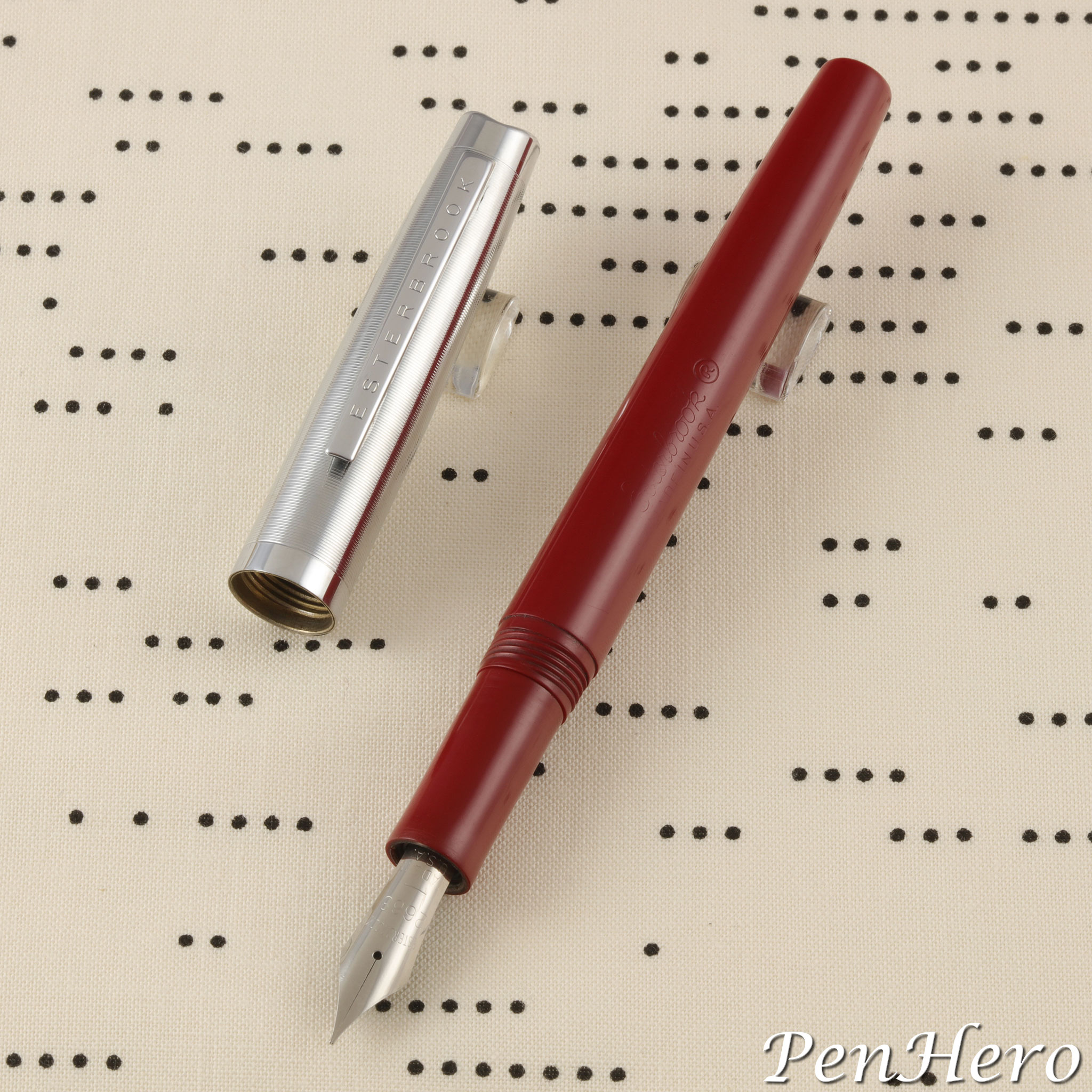 Esterbrook Classic M2 Cherry Red, second version, c. 1961-1962
Esterbrook Classic M2 Cherry Red, second version, c. 1961-1962
The Classic M2 wasn’t Esterbrook’s first or only metal cap pen. The earlier Deluxe, was essentially a metal capped J series pen, and the Safari and Plunger-Fill pens, released earlier than the Classic M2, also had metal capped versions. These were followed by the Classic M2, the Phaeton 300, and the CX-100 cartridge pen.
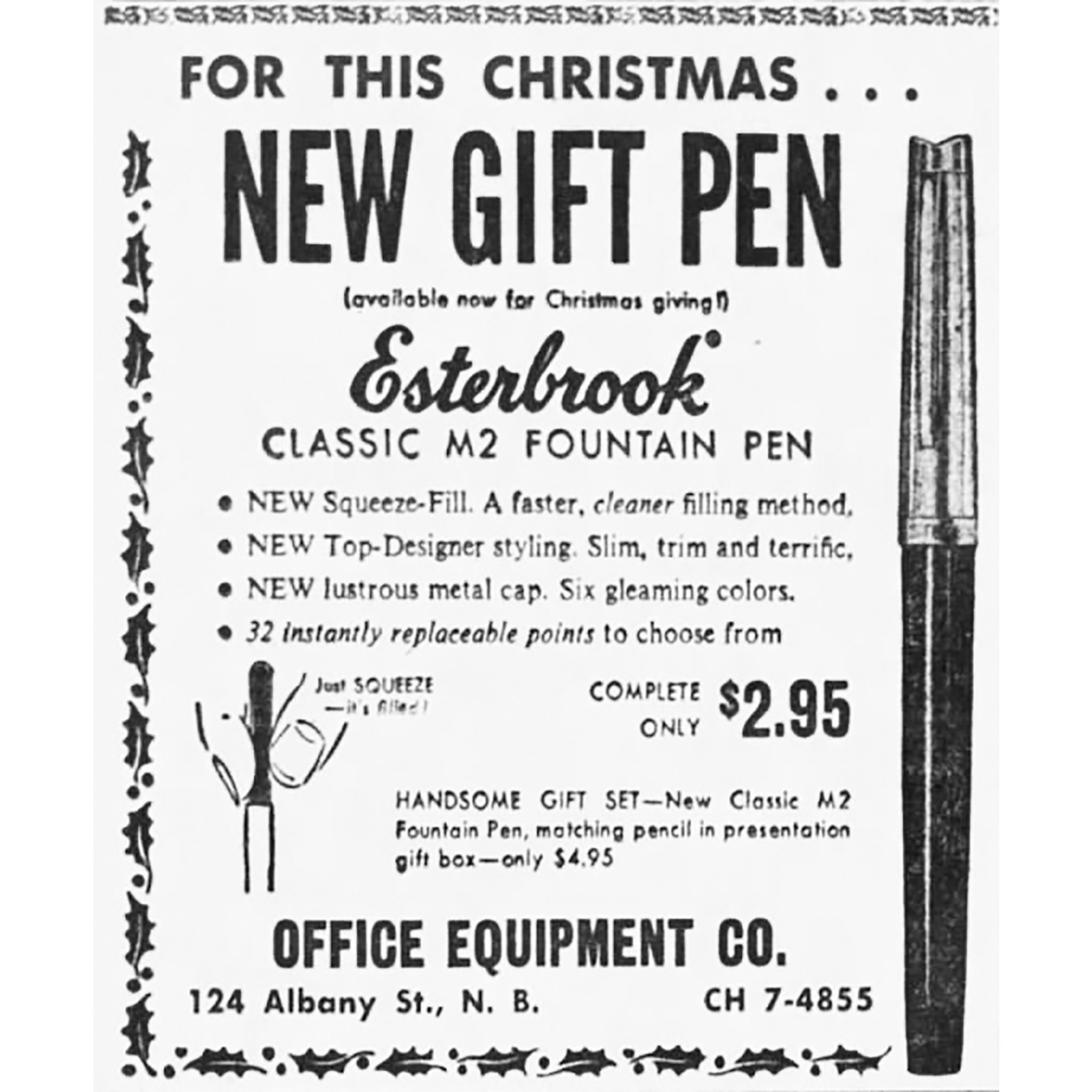 Advertisement in the Central New Jersey Home News, New Brunswick, New Jersey December 20, 1959
Advertisement in the Central New Jersey Home News, New Brunswick, New Jersey December 20, 1959
With only one catalog and company and retailer ads to review, piecing together the history of the Classic M2 is a little tricky. The earliest advertisements I could find of the Esterbrook Classic M2 are dated from December 1959. The pen shown in those two ads has a plain clip and the cap band has the Esterbrook markings.
The “new” features listed for the Classic M2 were:
- "Squeeze fill"
- “Top-Designer styling”
- “Lustrous metal” cap
 Advertisement detail in the St. Louis Post Dispatch, St. Louis, Missouri, November 12, 1961
Advertisement detail in the St. Louis Post Dispatch, St. Louis, Missouri, November 12, 1961
A new version of the Classic M2 can first be seen in an ad in the September 7, 1961 Lynchburg, Virginia News and Advance, which also shows the matching Esterbrook Scribe Deluxe push button ballpoint pen. It now has ESTERBROOK stamped on the clip face and a plain cap band. A triple set, with a fountain pen, pencil, and ballpoint pen are shown in the November 12, 1961 St. Louis Post Dispatch. The latest advertisement I was able to find showing the Classic M2 was in the December 9, 1962 San Francisco Examiner. It's possible they were still offered later, but retailers were no longer featuring them. This is why I peg the end date in 1962.
An Aerometric Filler?
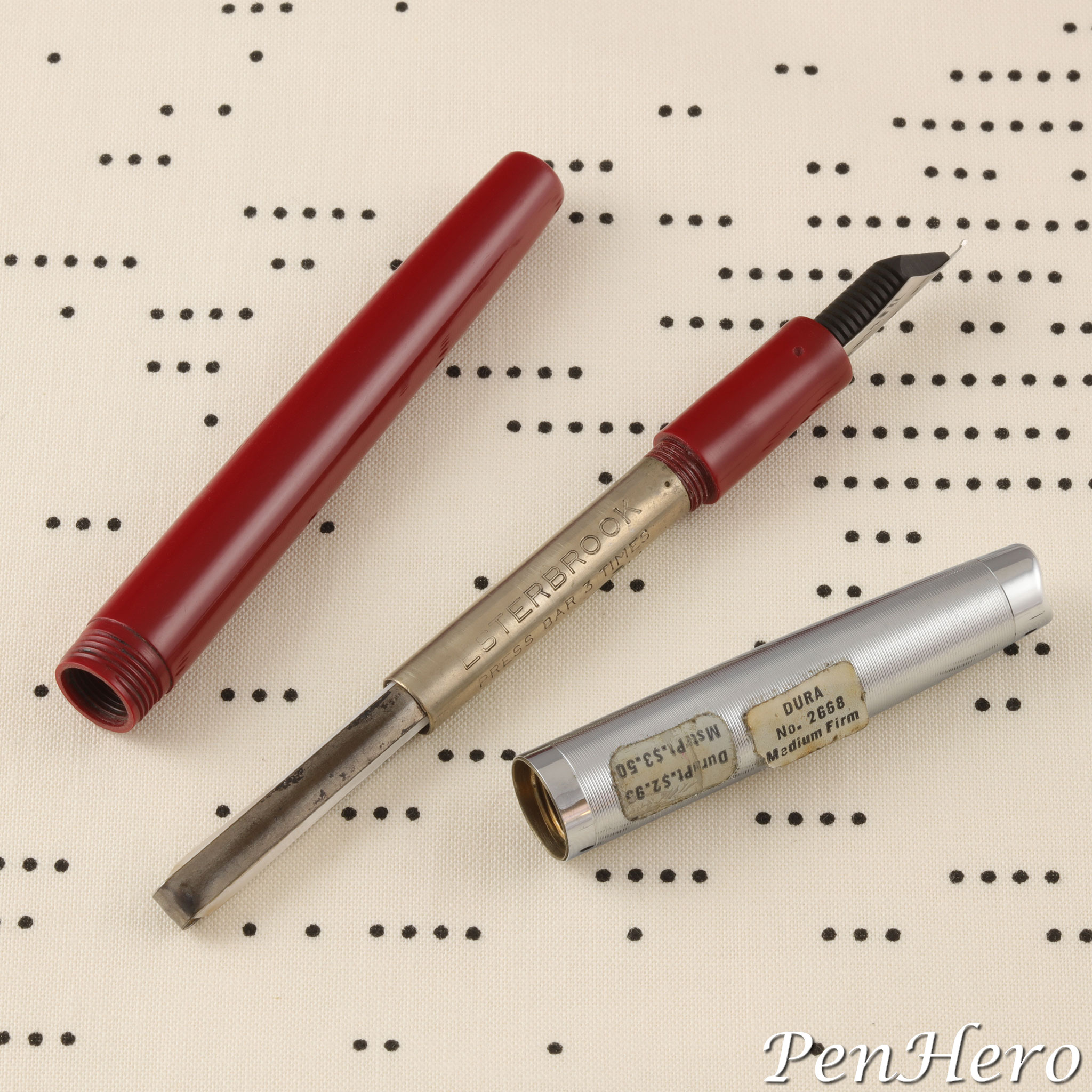 Esterbrook Classic M2 Cherry Red, second version, open
Esterbrook Classic M2 Cherry Red, second version, open
A lot of early squeeze filler pens get called aerometrics, after Parker's filling system that has a breather tube inside the squeeze filler unit. Esterbrook called the pen a “squeeze filler” and never made a claim that the Classic M2 has a breather tube. I’ve had a couple of them apart to check and found no breather tube inside. Some have clear ink sacs, and some have rubber sacs. I’ve never seen a reference that confirms that they should have a breather tube, so for now, I’m going to stick with calling them squeeze fillers, just as Esterbrook described them.
Designed by Henry Dreyfuss
The earliest advertisements for the Esterbrook Classic M2 announce that the pen had “Top-Designer styling,” which is revealed in a 1962 UK Esterbrook catalog as “designed by America’s leading designer Henry Dreyfus (sic).” A patent search reveals only one design by Henry Dreyfuss, patent number D183,917, assigned to The Esterbrook Pen Company and that was for the Esterbrook Scribe ballpoint pen, introduced in 1958. Maybe this design established the relationship that led to the Classic M2. Dreyfuss also designed a $3.95 desk pen for Esterbrook. There is nothing that looks like the Classic M2 in a search of other Esterbrook design patents. Perhaps Henry Dreyfuss and/or Esterbrook did not think the Classic M2 design needed a patent, since it’s actually a very simple concept. It looks to me like he glanced at his hat, and saw the crease in the top, and said, “That’s it!”
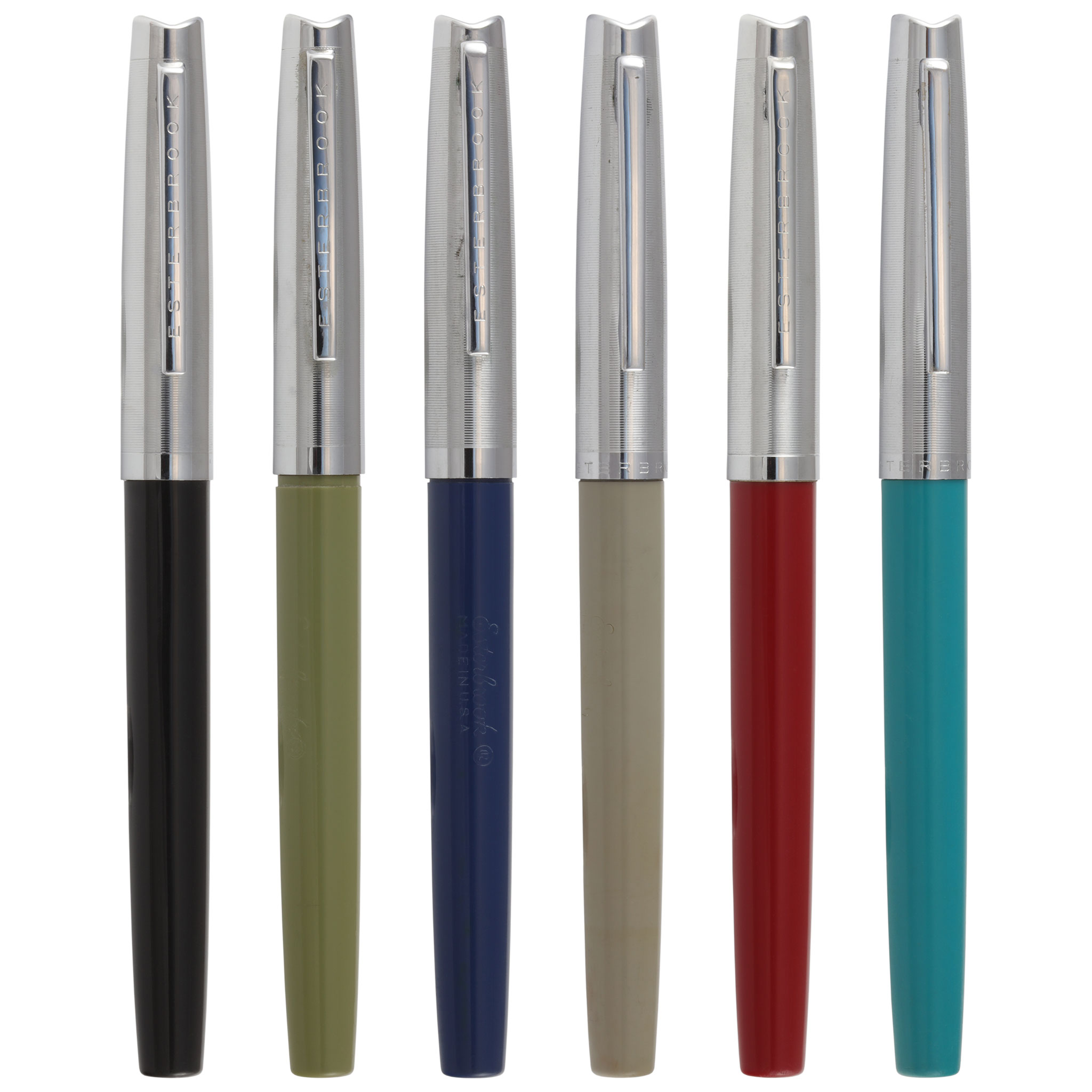 A panorama of Esterbrook Classic M2s showing all six colors and both cap designs
A panorama of Esterbrook Classic M2s showing all six colors and both cap designs
Henry Dreyfuss had a large portfolio of major industrial designs by the late 1950s, ranging from a streamlined locomotive, tractors, vacuum cleaners, and other commercial products. He already had experience designing pens, being awarded two patents, D132,663 on February 26, 1940 and D132,664 on February 1, 1941, for the Eversharp Skyline, which covered the overall cap and barrel design and the complex clip design. The Esterbrook Classic M2 design is much simpler. Considering the famous designer they were using, it’s interesting that Henry Dreyfuss’ name isn't mentioned in any Classic M2 company or retailer ads that I could find, only the 1962 UK catalog. I hope that Esterbrook catalogs from 1959 to 1961 will turn up so more on this could possibly be uncovered.
Identification Guide and Features: First Version c. 1959-1960
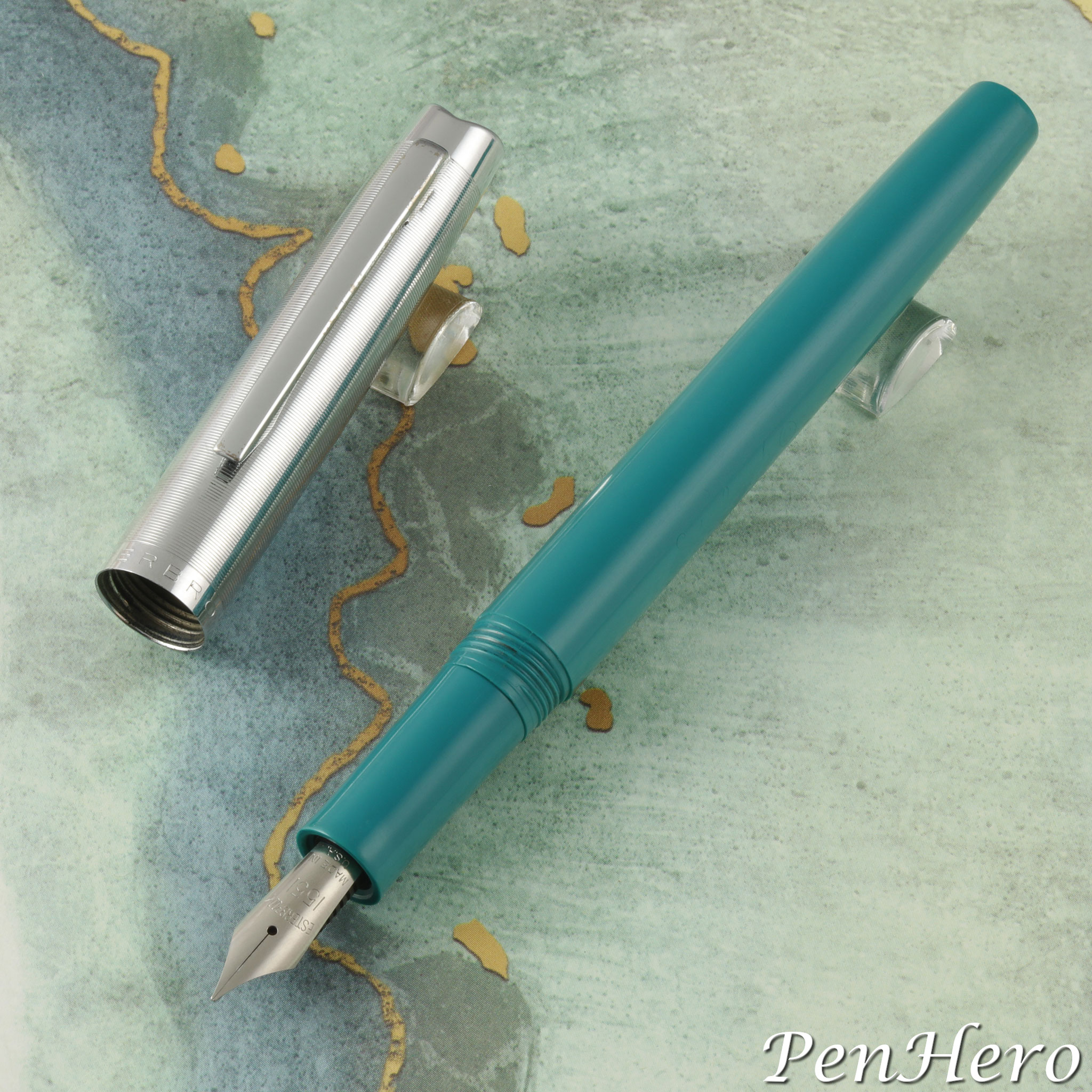 Esterbrook Classic M2 Turquoise, first version, c. 1961-1962
Esterbrook Classic M2 Turquoise, first version, c. 1961-1962
The first Esterbrook Classic M2 has a polished, band engraved stainless steel cap with a plain clip, and the cap band has ESTERBROOK and MADE IN U.S.A. stamped around the base. The barrel and section are matching color injection molded plastic in six solid colors. The barrel has a breather hole in the base and may or may not have a countersunk circle. The biggest visual clue that it’s a Classic M2 is the creased cap top. The Classic M2 can accept any of the many Esterbrook Re-New-Point nibs.
- Injection molded plastic cap and matching color section in Black, Mistletoe Green, Navy Blue, Light Gray, Cherry Red and Turquoise
- Barrel is stamped Esterbrook ® over MADE IN U.S.A.
- Polished clip that appears to be chrome plated
- Band engraved polished stainless steel cap
- Cap has plain 1/8 inch wide cap band stamped ESTERBROOK and MADE IN U.S.A.
- Threaded cap
- Stainless steel Esterbrook replaceable nib with 32 point choices
- Squeeze filler
- Squeeze filler sleeve is stamped ESTERBROOK over PRESS BAR 3 TIMES over TO FLUSH AND FILL
- About 5 1/4 inches long capped
- Advertised price for the pen was $2.95 and a set with a matching twist action pencil was $4.95
Identification Guide and Features: Second Version c. 1961-1962
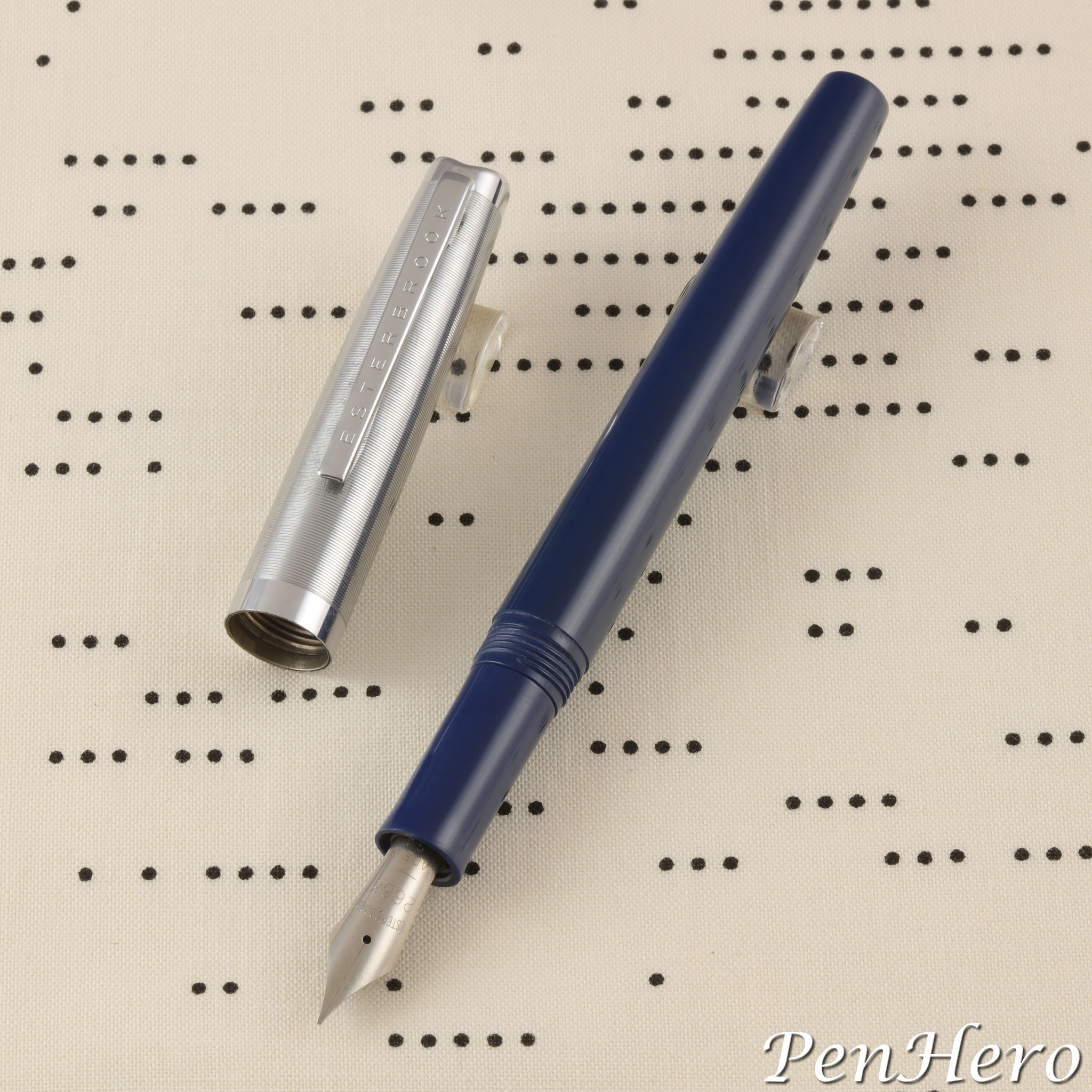 Esterbrook Classic M2 Navy Blue, second version, c. 1961-1962
Esterbrook Classic M2 Navy Blue, second version, c. 1961-1962
The earliest advertisement for this second version of the Classic M2 appears in September, 1961. The primary difference between the two versions are the clip and cap band stampings. These later pens have ESTERBROOK stamped on the clip face and have a plain cap band. The pens are otherwise identical.
- Injection molded plastic cap and matching color section in Black, Mistletoe Green, Dark Blue, Light Gray, Cherry Red and Turquoise
- Barrel is stamped Esterbrook ® over MADE IN U.S.A.
- Polished clip that appears to be chrome plated stamped ESTERBROOK down the face
- Band engraved polished stainless steel cap
- Cap has plain 1/8 inch wide cap band
- Threaded cap
- Stainless steel Esterbrook replaceable nib with 32 point choices
- Squeeze filler
- Squeeze filler sleeve is stamped ESTERBROOK over PRESS BAR 3 TIMES over PRESS BAR 3 TIMES over TO FLUSH AND FILL
- About 5 1/4 inches long capped
- Advertised price for the pen was $2.95, matching Scribe Deluxe push button ballpoint pen was $1.95, a set with a matching twist action pencil was $4.95, a three piece set was $6.90
Performance
For me, the best thing about any pen that uses Esterbrook Re-New-Point nibs is going to be the nib. Yes, most Esterbrook pens are solid, no frills utility players, but the fun of being able to put in your favorite nib can’t be understated.
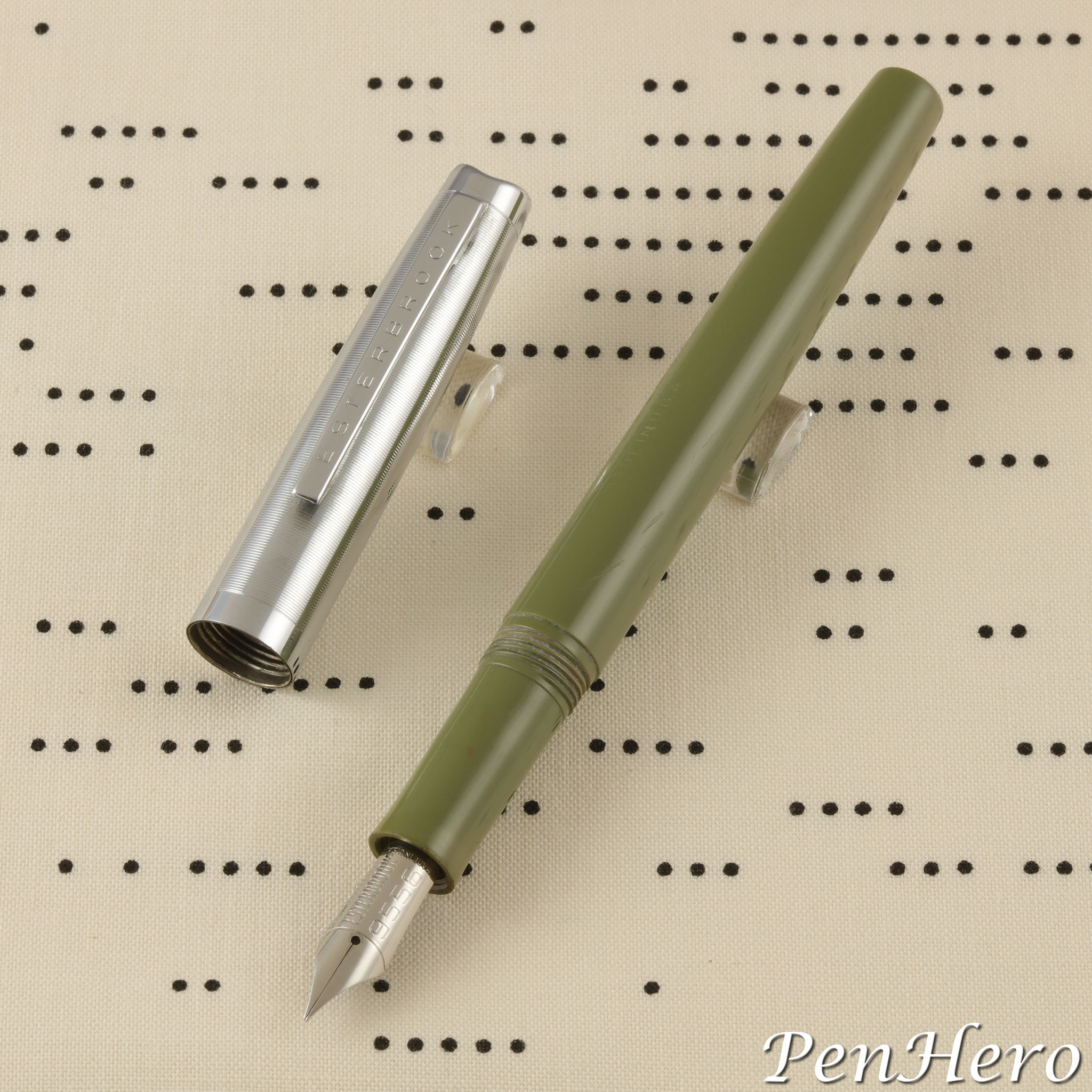 Esterbrook Classic M2 Mistletoe Green, second version, c. 1961-1962
Esterbrook Classic M2 Mistletoe Green, second version, c. 1961-1962
I picked a beat up Classic M2 for the test drive simply because I didn’t want to worry about inking a new one. The fit and finish on all the examples I photographed are pretty good, with only the heavily used ones showing any issues. These pens are about 5 1/4 inches long capped and 6 1/8 inches posted. They post securely, but the metal cap edge can scuff the barrel.
My test pen had a rubber ink sac while some of the others had clear ones. I’m not sure which is original equipment or if they both are. The cap appears to be pretty resistant to scuffs, probably because it’s polished stainless steel, but the barrel is a fairly soft injection molded plastic that picks up scratches pretty easily. Expect this if you collect them.
The nib on my test pen is an Esterbrook 2668 firm medium, a pretty common nib and could be original to the test pen. It’s a nice writer, reasonably wet on paper, and puts down a smooth even line. All as expected.
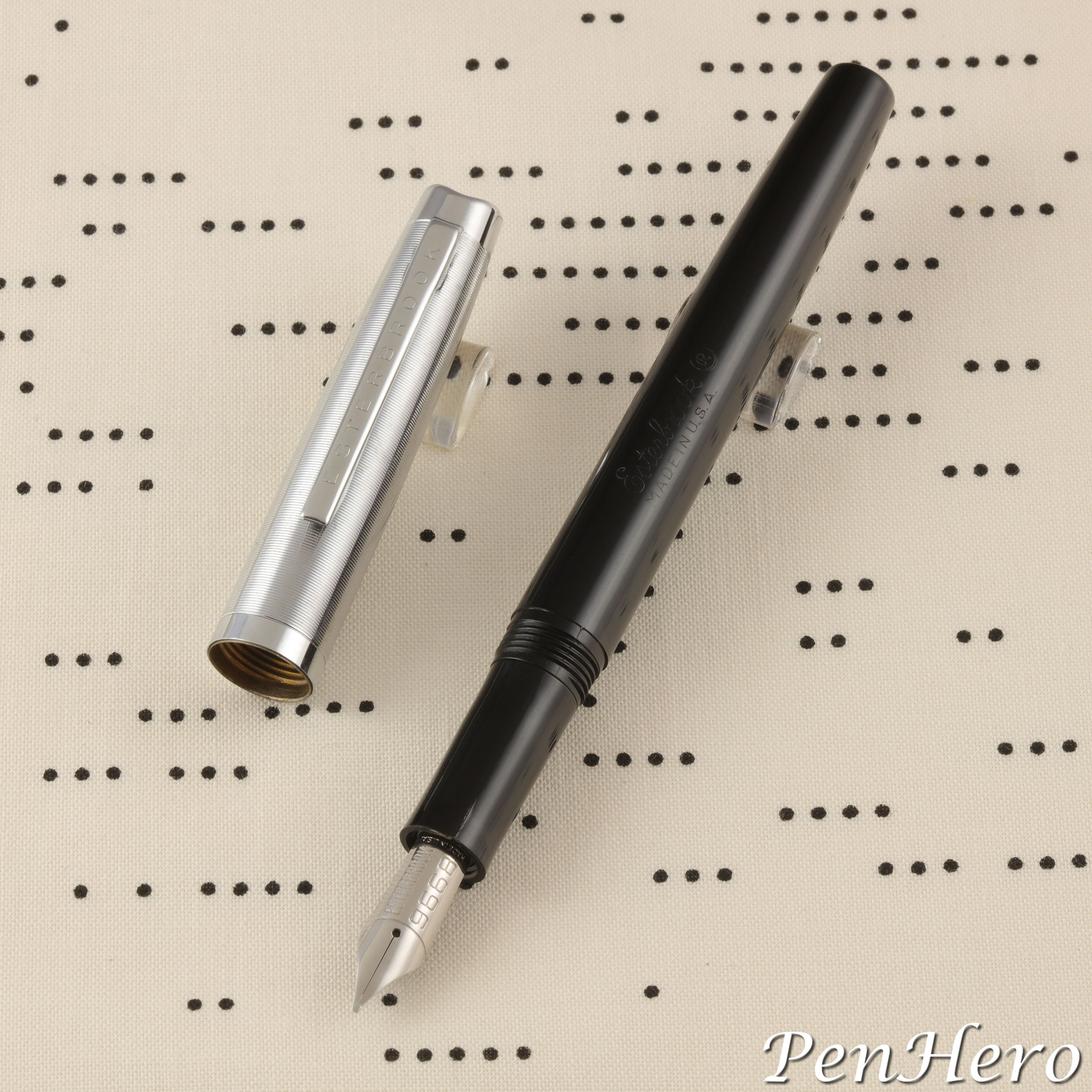 Esterbrook Classic M2 Black, second version, c. 1961-1962
Esterbrook Classic M2 Black, second version, c. 1961-1962
Esterbrook pens are generally less expensive to collect than top line brands. Lots were made, they are easy to service, and reliable examples are not hard to find. They are a great first pen for pen collectors as well as for writers who want a good fountain pen with a lot of nib choices.
The Classic M2 is a bit of an oddball with its squeeze filler, but it’s a fairly simple sac replacement and it uses any of the Esterbrook Re-New-Point nibs. The sac holder will require some heat to gently pull it off the back of the section, so take care removing it. Since there are only two cap types and six colors a complete collection would not cost much and should be fairly easy to work on. I really don’t see the Classic M2 as a collectible. If anything will be a challenge, it will be finding a Light Gray one that isn't ink stained, as that color seems to be highly susceptible to it. These are workhorse pens that make a good entry point for new collectors who want something different from the J series lever fill pens. They’re a different and fun addition to the Esterbrook line.
References
Advertisement, Chicago Tribune, Chicago, Illinois, October 27, 1958, page 55
Advertisement, Saturday Evening Post, November 7, 1959, page 6
Advertisement, Saturday Evening Post, November 21, 1959, page 84
Advertisement, St. Louis Post Dispatch, St. Louis, Missouri, November 12, 1961, page 13
Advertisement, The Central New Jersey Home News, New Brunswick, New Jersey December 20, 1959, page 14
Advertisement, The News and Advance, Lynchburg, Virginia, September 7, 1961, page 10
Advertisement, The News and Observer, Raleigh, North Carolina, December 11, 1959, page 2
Advertisement, The Ottawa Citizen, Ottawa, Ontario, October 3, 1960, page 19
Advertisement, The San Francisco Examiner, San Francisco, California, December 9, 1962, page 12
Advertisement, The State, Columbia, South Carolina, December 14, 1960, page 2
Esterbrook Catalog, The Esterbrook Pen Company, Ltd., Birmingham, England, June 7, 1962
"Esterbrook Confident in '59 Outlook" by Sydney E. Longmaid, President and Board Chairman, Esterbrook Pen Co., Courier-Post, Camden, New Jersey, January 20, 1959, page 45
Esterbrook M2 Aerometric Pens, Esterbrook.net, copyright © 2015 by Brian P. Anderson
"Hall Marks" by Jane Hall, Courier-Post, The News and Observer, Raleigh, North Carolina, March 27, 1960, page 17
United States Design Patent D132,663, awarded February 26, 1940
United States Design Patent D132,664, awarded February 1, 1941
United States Design Patent D183,917, awarded November 18, 1958 to Henry Dreyfuss and assigned to The Esterbrook Pen Company of Camden, New Jersey
Interact
Comments on this article may be sent to the author, Jim Mamoulides


